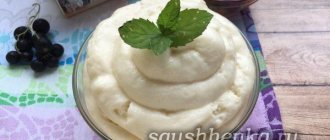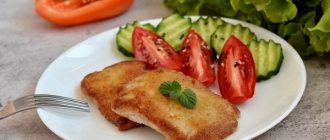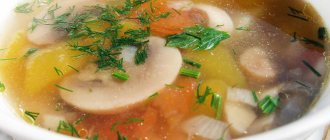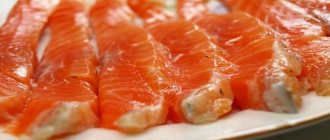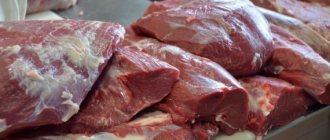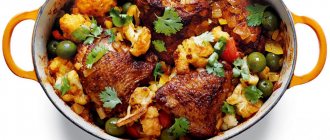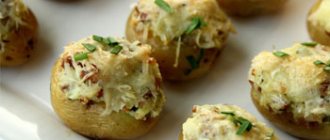Author: Eva Tushenkina
09 May 2021 18:59
Tags: cooking chef from God cooking secrets tricks in the kitchen.
176215
21
Everyone will think that you are a professional chef. Maybe you will even be invited to act as an extra in the next episode of “Kitchen.”
0
See all photos in the gallery
Baking Tips
- Loose dough. I advise you to make a depression in the center of the dough and add a little milk. Gently mix with a fork, and then knead the dough into a homogeneous ball.
- The dough doesn't rise. If your dough does not rise, there can only be two reasons for this: either the kitchen is too cold - the temperature is less than 22 degrees, or you did not heat the milk before mixing it with the yeast. The temperature of the liquid mixed with yeast should be approximately equal to body temperature, that is, 36 degrees.
- Egg whites do not whip to a stable foam. Whipping egg whites is not the easiest task, but problems can be avoided by following a few rules. First: the container in which you will beat the egg whites must be completely dry; even a couple of drops of water can interfere with whipping. The second is how carefully you separate the whites from the yolks, this should be done very carefully. But if after 3 minutes the proteins have not acquired a stable form, it means that you did something wrong.
- When baking, the raisins sink to the bottom. This problem indicates that the dough is very liquid. If the batter does not pour out of the spoon when transferring it to the pan, the raisins will remain in place. The solution is simple - add a small amount of flour.
- The cake settles during baking. You may have used more liquid than the recipe called for. Or you may have been beating the dough with an electric mixer for too long. In both cases, the dough will begin to rise, but will collapse during baking. Therefore, it is very important to follow the advice given in the recipe. In both cases, the solution to the problem is to add a little extra dough.
- The cookies are stuck to the baking sheet. It is best to bake the cookies on greaseproof paper, then there will be no problems with sticking. But if you still don’t have it, and you didn’t have time to quickly transfer the finished cookies from the baking sheet and they stuck, then you should do the following: heat the oven again to the required temperature, put the baking sheet back in the oven and warm up the cookies. After this, you can easily transfer the cookies, but you need to do this immediately.
- The cookies break when removed from the baking sheet. Again, it is worth saying that perhaps the most convenient solution to this problem is to use greaseproof paper. Thanks to it, the baking sheet does not need to be greased and you will not have any problems when removing cookies. An additional benefit of greaseproof paper is that it does not need to be washed and can be reused several times.
- The dough with vegetable oil and melted cheese is too soft. This happens if the processed cheese or cottage cheese is too wet. Therefore, it is advisable to always squeeze the cottage cheese or wrap it in a towel to dry before using it.
- The finished curd cake settles. You must remember that finished cheesecakes always shrink in volume, especially in the center. Therefore, you need to put a little more dough in the center than on the edges. When the baking time is up, leave the cheesecake in the oven with the door closed until the temperature drops.
- Burnt cake. All you can do is scrape or cut off the burnt crust with a sharp knife. For disguise, it is best to cover the cake with frosting.
- Wet fruit pie. Many fruits release juice when baked. Sprinkling the dough with bread crumbs before adding the fruit will help keep the cake from getting too wet.
- Caramel hardens too quickly. It can remain smooth and runny if you add a little lemon juice while cooking.
- To prevent the filling from running away when baking a fruit cake, stick a few macaroni pieces into the cake; the juice will rise up through these tubes, and the baking sheet will not burn.
- When frying donuts, vegetable oil creates foam. If the vegetable oil foams, it has not reached the required temperature, which can destroy the thin layer of dough. To prevent this, check the temperature by dipping the handle of a wooden spoon into the oil. The oil has reached the desired temperature when small bubbles form around the handle.
- A doughy cake is difficult to cut. When you cut a cake, the knife should not go straight to the very bottom, but should move in a sawing motion through the entire cake. It is best to use a serrated knife for this.
- Frozen custard. Transfer 3 tbsp. spoons of custard into a bottle. Cool it down by placing the bottle in cold water. When cool, shake vigorously and the custard will return to normal.
The smell of garlic
Garlic can add flavor to almost any dish. But this ingredient also has one significant drawback - a persistent and unpleasant odor that remains in the mouth and on the hands. Lemon juice will help remove the smell of garlic from your hands. You need to wash your hands well with soap and then wipe them with lemon juice. Peeled nuts or parsley roots will help eliminate bad breath. Chew the selected product thoroughly until a paste forms and spit it out.
Tips for preparing first courses
- Mushroom broth will be more flavorful if you use mushrooms of different sizes. Large ones add flavor and color to the broth, while small ones add aroma. The best mushrooms for puree soup are champignons, porcini and morels. And legume soups made with mushroom broth are especially good.
- In order for the foam that sank when cooking the broth to rise, you need to add a little cold water. To make the broth aromatic and tasty, you need to cook it over low heat.
- The puree soup can be seasoned with crumbs soaked in broth and grated to give it the necessary thickness. Such soups cannot be boiled after seasoning.
- Fish broth will taste better if you cook different types of fish together. If fish heads are boiled, the gills must be removed, otherwise the broth will be bitter and cloudy.
- However, a cloudy broth can be easily lightened with egg whites beaten with salt.
- Those who like clear rice soup should definitely rinse the rice and put it in boiling water for 3-4 minutes, then put it in a sieve. After this, you can cook it until tender, the broth will remain clear.
- If you put too many vegetables in beef broth, it will lose its specific taste and aroma. As for chicken broth, do not overuse seasonings, otherwise it will lose its taste. Here's something else useful to remember: vegetables for fish and mushroom broths can be fried in margarine and vegetable oil, but for milk soups - only in butter.
- When preparing pickle soup, you should remember that the potatoes will become tough if you first add pickles or sorrel to the soup. Sorrel (and nettles) should be placed in almost finished soup and boiled in an open container, then they retain their natural color.
- If the pickle is with pearl barley, then it is better to sauté the cereal in oil. This significantly improves the taste. For spiciness, you can add boiled, strained cucumber pickle to the pickle.
- First courses often include fried onions, so they will brown nicely if you add a little granulated sugar to the oil in the frying pan. Before sautéing, it is better to roll finely chopped onions in flour, then they will not burn and will acquire a reddish tint.
- To prepare milk soups, pasta and cereals are pre-boiled for 3-5 minutes in water.
- When cooking cabbage soup, you need to put sauerkraut in cold broth (water), and stewed cabbage in boiling water.
- Vegetable soups without cereals and potatoes should be seasoned with flour sauté, they will be thicker.
- Game soup will taste better if it is fried beforehand.
- It is recommended to cook milk soups in a saucepan with a thick bottom and over low heat to avoid burning.
Fish secrets
- Let the thawed fish stand until it is completely defrosted. Large pieces can be kept under cold water for final thawing.
- Frozen fish retains its nutrients better if it is thawed in cold, salted water.
- The fish should be cooked in a closed container so that the moisture does not evaporate and less time is spent on cooking.
- To make it easy to remove scales from the fish, immerse it in boiling water for a few minutes, then in cold water.
- To find out if the fish is benign, it is lowered into a bowl of water. When immersed in water, fresh fish drowns. Or pay attention to the gills. If the gills are red, then the fish is fresh. If they are very dark or pale, they are not fresh.
- River fish will not smell like mud if you wash it in a strong cold salt solution or put it in water with vinegar an hour before cooking (2 tablespoons of vinegar per liter of water).
- Small fish tastes better. The larger the fish, the tougher its meat.
- To ensure even cooking, large, thick pieces should be placed around the edges.
- Always cook the fish last. It should not be reheated like other foods, as it will quickly overcook.
- It is important to defrost the fish completely so that further cooking proceeds evenly. When defrosting, you need to put the fish in a glass or some other container and cover it with film.
- The fish will not be overcooked if you salt it 10-11 minutes before cooking.
- Pieces of fish will not lose their shape during cooking if 2 - 3 shallow transverse cuts are made on them.
- Ocean fish turns out especially tasty when boiled in cucumber brine.
- Sea fish will become even tastier if you sprinkle it with lemon juice 15-20 minutes before frying.
- When boiling fish, it is recommended to immerse it in boiling water, then it will retain its juiciness and delicate taste.
- For fatty fish, it is better to use sauces that have a sour taste - with vinegar, lemon juice, wine. They soften the taste of fat.
- All large fish intended for cooking are first placed in cold water.
- Crayfish should only be boiled alive. If, after boiling, the neck of a crayfish is not tucked in, but is loose, it cannot be eaten; in a live-cooked crayfish, the neck is always tucked inward.
- If there is the slightest doubt about freshness, oysters, fish and crayfish should be thrown away without any regret.
- It is good to garnish fish products with slices of lemon, tomato, and spices.
- To ensure that the fish is well browned, you need to dry it with a towel before frying.
- If the fish has been over-salted, the mistake is corrected in this way: unleavened flour sauce, unsalted mashed potatoes, sour cream mixed with a lot of herbs (dill, parsley), lightly stewed with onions along with the over-salted fish. However, this method is ineffective if the fish is very salted.
- Fishy and onion smells can be removed from the boiler and frying pan by sprinkling moistened tea leaves onto a hot surface.
Powdered sugar
You needed powdered sugar, but as luck would have it, you don’t have it? Don’t rush to run to the store, because powdered sugar is granulated sugar crushed into dust and it’s not difficult to make it yourself. Use a coffee grinder, mortar, spice grinder or blender to crush the sugar and turn it into powder.
Use a slow cooker
This kitchen helper is a great time saver. In the evening we put in the food, set the program for a certain time, woke up in the morning - the porridge was ready. The same goes for dinner: when you come in the evening, the stew has already been cooked in the slow cooker and a hot meal is waiting for you, there’s no need to waste any more time. And when you come home from work tired, it’s simply a blessing to receive a hot, ready-made dinner.
As you can see, to learn how to cook quickly, you don’t need much. We hope you find our tips and secrets of quick cooking useful.
Milk secrets
- To make the milk boil faster, you can add a little sugar to it.
- The milk will not escape if the edges of the pan are greased.
- You can preserve milk longer in the winter like this: before boiling, add a little sugar to it (1/2 tablespoon per 1 liter of milk), and in the summer - soda (on the tip of a knife).
- To boil milk without foam, you need to set it to boil, stir it often, not allowing foam to form, and as soon as it boils, quickly cool it. Do not let it boil for more than three minutes - the vitamins will be better preserved.
- You can preserve milk longer this way: cover the container with milk with a lid, place it in a pan filled with water, throw a napkin or towel on top, immersing its ends in water.
- Milk will not burn if you boil it in a thick-bottomed pan after rinsing it with water.
- If the milk is still burnt, you can get rid of the unpleasant smell like this: immediately pour it into another bowl, place it in a bowl of water, add a pinch of salt to the milk and shake lightly.
- Milk will not turn sour if you put a horseradish leaf in it.
- Milk absorbs odors very quickly, so it should be stored in a container with a closed lid.
- Sour cream will whip up better if you add a little raw protein to it.
- To remove acid from cottage cheese, you need to wrap it in gauze, folded in two layers, squeeze it into a ball, and twist the ends tightly. Place the cottage cheese on a cutting board, cover with another board on top, put a small weight and leave for 2-3 hours.
- Very sour cottage cheese will lose acid and become tender if you mix it with an equal amount of fresh milk and leave for an hour, then, putting it on cheesecloth placed in a colander, let the milk drain, and put the cottage cheese under a press.
Based on materials: https://racion.net/kulinarnyi_blog/
How to preserve vitamins
- Products such as meat, chicken, eggs and so on are very dangerous to eat raw. On the other hand, we all know that when these products are cooked, they lose a significant part of their nutrients.
- Vitamins such as K and B are very stable and are always preserved when cooked. Vit. A, E, D are very tender, and to preserve them, we cook these products in the smallest amount of oil.
- To reduce the loss of valuable vitamin C, cook fruits and vegetables in as little water as possible. This will reduce the cooking time, thereby preserving vitamin. C. It is necessary to consume boiled vegetables immediately, since after 24 hours they lose 50% of their beneficial substances.
- Carrots and potatoes, boiled in their skins, will retain up to 65% vit. WITH.
Secrets of cooking meat and meat products
- Do not start cooking meat until it is completely defrosted.
- If the meat has an unpleasant smell, you need to add one or two pieces of charcoal when cooking it, which will absorb the smell. Or cut the meat into pieces, wash thoroughly in cold water, place in a saucepan with coal and pour cold water to cover the meat. After two to three hours, remove the coal and cook the meat in the same water. Or wash the meat with lukewarm water, rub with salt and pepper and leave for a quarter of an hour.
- Large pieces should be turned over for even defrosting.
- Do not salt the meat until the end of cooking, especially dense pieces. If you salt raw meat, the surface will dehydrate and become tough.
- When frying meat in the oven, pour only hot water or broth over it; cold water gives it firmness.
- Tough meat will become soft if: - beat off the pieces; - moisten with lemon juice, let it absorb, fry in a heated frying pan; - Spread mustard on all sides for several hours, and before cooking, rinse and lightly salt.
- Lean meat is stuffed to increase fat content. Lard sticks, 5-6 cm long and 0.5 cm thick, are inserted into the meat by stuffing or stuck into punctures in the meat made with a sharp knife. To improve the taste, fatty meat is stuffed with pieces of onion, parsley, and celery.
- Meat should always be cut across the grain, then the finished pieces will be beautiful.
- It is better to use the meat of young animals for fried dishes, and old meat for boiling and stewing.
- To ensure that the fried meat is juicy, do not serve it immediately from the frying pan, but hold it over a pan of hot water for a quarter of an hour.
- Roast beef acquires a pleasant taste if the meat is coated with mustard several hours before cooking and then simmered.
- Chops and schnitzels will turn out softer if you spread them with a mixture of vinegar and vegetable oil 1 - 2 hours before frying.
- Boiled meat will be juicy if you put it in a large piece in boiling water, and then cook over low heat with the broth barely simmering.
- It is easy to remove the film from the liver if you dip it in hot water for a minute.
- The liver becomes very tasty if you soak it in milk for 2-3 hours before frying. The liver is fried unsalted, otherwise it will become hard.
- If the fried liver has become dry and hard, pour sour cream or sour cream and onion sauce over it, bring to a boil and simmer over low heat until the liver becomes soft. When serving, the liver should be poured with the sauce in which it was stewed.
- To ensure that the breadcrumbs do not remain in the pan when frying the cutlets, but cover the product with a golden-brown crispy crust, the cutlets must be properly breaded. To do this, you first need to roll the meat in flour, then brush it with beaten egg and only then bread it in breadcrumbs.
- If you have over-salted the basics or stews, you can add pre-chopped and sautéed fresh tomatoes to the dish; the salt will be less noticeable.
- Boiled chicken will taste better if, after removing it from the broth, you salt it and then put it in another pan, covering it with a lid or towel.
- If you have over-salted the meat, you need to add an unleavened flour or butter sauce to the dish, which will “pick up” the salt. You can add sour cream to fried meat: to do this, place hot, salted meat in a bowl with cold sour cream, cool the meat and only then heat it (preferably in a water bath).
- If the beef kidneys in the sauce have a sharp, unpleasant odor, the kidneys need to be separated from the sauce, rinsed with hot water, filled with cold water again and brought to a boil. Then fry and combine with the newly prepared sauce.
- Some varieties of smoked sausage are quite difficult to peel. But if you put the sausage in cold water for half a minute, then peeling it will not be difficult.
- If there is no refrigerator, fresh meat can be preserved for 24 hours by wrapping it in a thin cloth soaked in vinegar.
- Sausages will not burst when cooked if you pierce them with a fork before putting them in water.
- Dumplings and dumplings are boiled for 4 - 6 minutes in salted water. They are ready when they float to the surface of the water. The readiness of the noodles is also determined.
- The meat will remain fresh for 4 - 5 days if, after drying, put it in a pan (enamel), pour in sour milk, cover with a plate, press down with a weight and put in a cool place.
What don't chefs order in restaurants?
When visiting restaurants and reading menus, some chef positions are usually avoided. Most often this is:
- Chicken and pasta dishes: the cost of the products from which they are prepared is low, and the price on the menu corresponds to the average price of the main dishes, so the markup on them is maximum. They are also often the least interesting dishes a restaurant offers.
- Salmon dishes: This is a standard product for many restaurants, and the likelihood that you will be prepared something memorable is extremely low.
- Vegetarian or vegan dishes in regular restaurants: everything is prepared in one kitchen, so these dishes often contain animal ingredients.
- House wine: this name often hides cheap table wine with a huge markup. For those who do not understand wines, professional sommeliers recommend choosing not the cheapest wine on the wine list, but the second most expensive wine, since it is often the one that has the best price-quality ratio.
If a restaurant has a dirty toilet, it’s better not to eat in it at all: as a rule, this means that the kitchen is even dirtier.
Tricks for making delicious cutlets
- When making cutlets, it is very useful to place a piece of ice and a piece of butter in the middle of each cutlet for juiciness.
- First, over high heat, fry the cutlets once on each side until a crispy crust is obtained, and then reduce the heat, cover the pan with a lid and leave on low heat for another 10-15 minutes. The finished cutlets are immediately served to the table.
- Bread for minced meat should be soaked in cold boiled water (in some cases it can also be in wine or a mixture of wine and water), but in no case in milk (soaking bread in milk deprives the cutlets of juiciness due to the interaction of milk proteins during frying and meat).
- Cutlets (or meat) should only be placed in a very well preheated frying pan (20-30 seconds after the cook has a strong alarm that the frying pan is already too overheated) and with a sufficiently thick layer of oil (a small amount of oil makes it difficult to transfer heat from the frying pan to the cutlet or meat, as a result of which the product loses its juiciness, because due to poor thermal contact the crust forms slowly, especially on the side surface).
- You cannot add eggs to minced meat cutlets, otherwise the cutlets will lose their juiciness (eggs are added to minced meat cutlets as a binder only in catering, so that more water and bread can be added to the cutlets - without eggs, the minced meat with not enough meat will fall apart); Eggs must be added as a binder to minced fish cutlets, also when preparing minced cutlets from vegetables or cereals.
- The molded cutlet must be rolled in a loose egg - lezone (or, even better for preserving juices, first a little in flour and then in the egg) - when frying, the egg will create an impenetrable shell and retain all the juices inside the cutlet (if desired, after rolling in egg, you can bread the cutlets in ground breadcrumbs); – partial breading: only in egg or only in flour, or in flour and then in egg; – full breading (Viennese breading): flour – egg – crackers; – sometimes double breading is used: flour – egg – crackers – egg – crackers); – chicken, fish, cereal and vegetable cutlets, after dredging in flour and very generously in egg, can be breaded in fresh, not too small bread crumbs or in fresh bread, cut into thin (3-4x6-8 mm) and fairly long strips (this breading requires quite a lot of oil in the pan).
Tips for cooking in the microwave
Our century is the century of speed and high technology. We are constantly in a hurry, there is a catastrophic lack of time, and glory to Technology, which makes our lives easier! So it's not surprising that microwave ovens are so popular. Food in the microwave is, firstly, fast, secondly, convenient, and thirdly, simple! A microwave oven is used not only for heating and defrosting food; you can also cook in it: bake, fry and boil. In addition, you can do a lot of useful things using a microwave.
- To freshen up the aroma of ground spices and seasonings, heat them on full power for thirty seconds.
- If you wrap stale bread in a paper towel and heat it on full power for one minute, the bread will become fresh again.
- Walnuts can be easily peeled by heating them in water for four to five minutes at full power.
- Almonds are easy to peel if you put them in boiling water and heat them for thirty seconds at full power.
- An orange or grapefruit can be easily peeled of its white pulp by heating it for thirty seconds at full power.
- You cannot overcook cheese in the microwave, otherwise it will become dry and rubbery.
- The fish will become more aromatic and tastier if you pour it with butter and paprika.
- A microwave oven will help squeeze out the juice from a lemon or orange to almost a drop, even with very thick citrus peels. Warm the fruits in the microwave for a few minutes, let them cool, and you can easily squeeze the juice out of them.
- You can quickly and easily dry the zest of oranges and grapefruits in the microwave. Place it on paper towels and heat at full power for two minutes. While heating, the zest needs to be stirred. After cooling, it becomes dry and brittle. Store dried zest in a tightly sealed container.
- In the microwave you can dry herbs, vegetables, as well as crackers and nuts for the winter.
- But this is not all that a microwave baby is capable of. Eating food in the microwave is already commonplace, but microwaves can be used not only for food.
- You can melt the candied honey in 1-2 minutes.
- From many small cinders you can make one normal candle - collect the cinders in a bowl, melt them, and then pour them into a mold with a thread wick.
- Sterilize dishwashing sponges. It is not at all necessary to throw them away; they can be perfectly “reanimated” in the microwave. You can also remove ingrained odors from cutting boards in the microwave - you need to wash them, rub them with lemon and “fry” them in the microwave.
- You can quickly make an excellent homemade heating pad by pouring cereal or salt into a clean sock and heating it for a couple of minutes.
- The same goes for soap – the remnants can easily be turned into one whole piece.
Hot peppers
Anyone who has ever used hot peppers, be it chili peppers, jalapenos or any other, knows about the unpleasant burning sensation on the fingers and more serious burns that can be earned by handling them carelessly. Olive oil will help remove the burning sensation from your hands. Lubricate your hands with it before and after handling pepper. Compresses made from cotton pads soaked in milk will help relieve the burning sensation in the eyes.
Why don't restaurants use non-stick pans?
They are used, but rarely, only when it is really justified - for example, when frying eggs or omelettes, fish, pancakes or cheesecakes, and even then not always.
No matter how durable such a coating may be, active use in any case reduces its life to a minimum, after which using a non-stick frying pan simply becomes dangerous to health.
The cost of such frying pans also does not make their use economically justified, but it’s not even about money. Simply, a frying pan with a non-stick coating often does not distribute heat evenly enough, and the coating itself does not allow achieving a high-quality crust when frying.
